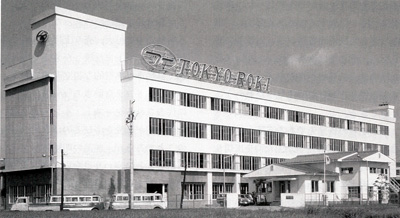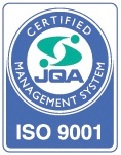Embracing New Change with Wisdom and Enthusiasm
| 1949 Mar. | Tokyo Roki Co., Ltd. was established (at Denen-chofu, Ota-ku, Tokyo) to start manufacturing and selling air cleaners and oil filters for internal combustion engines. |
|---|---|
| 1952 Apr. | The engineering department was organized to start developing filter papers. |
| 1955 Jun. | The Headquarters building and Kawasaki Plant were completed at Ichinotsubo, Kawasaki-shi, and business operations were relocated there. |
| 1958 Feb. | Various filters for airplanes passed approval tests by the Self-defense Agency of Japan. |
| 1960 Apr. | Manufacturing of mufflers for internal combustion engines was started. |
| 1961 Jan. | Local offices were opened at Nagoya, Osaka and Hiroshima. |
| 1962 Sep. | IBM computers were introduced to start computer-processing of office processing. |
| 1964 May. | Yokohama Plant was completed, production systems for elements were established, and platinum-catalyst purging mufflers for diesel engines were developed. |
| 1965 Oct. | Eight offices/plants were in operation nationwide |
| 1966 Sep. | Yokohama Plant started commercial production of new-concept “throw-away type cartridge filters”. |
| 1966 Dec. | Kusatsu Plant was completed (in Shiga-ken) to start commercial production of air cleaners. |
| 1967 Jul. | The demonstration running tests with actual vehicles of exhaust-gas purging mufflers were started. |
| 1969 Apr. | Hiroshima Plant was completed (in Hiroshima-ken) to start manufacturing air cleaners. |
| 1971 Apr. | Sagami Plant (in Kanagawa-ken) was completed to start manufacturing oil coolers. |
| 1972 Apr. | The Tokyo Roki Technical Center was opened as the largest filter-related research center in Japan. |
| 1974 Oct. | Hamamatsu Plant was completed (currently Tokyo Roki Nagura Seisakusho Co., Ltd.) and mass-production systems for cartridge filters were established there. |
| 1976 Mar. | Otsuki Plant was completed to start manufacturing air cleaners. |
| 1976 Nov. | Toner filter elements for dry reproducing machines were developed. |
| 1979 Nov. | The Headquarters was moved to a new Headquarters building at Shin-yokohama (in Minatokita-ku,Yokohama-shi). |
| 1984 Mar. | The Technical Center was relocated to the Headquarters building. |
| 1984 Apr. | Yokohama Plant was opened, making it a center for developing parts for special equipment and products. |
| 1985 Jun. | Systems for computational structural analysis were introduced. |
| 1992 Apr. | The TIS (integrated group-wide online network system) started full-scale operations. |
| 1995 Aug. | The new Headquarters and Research Center were completed (at Tsuzuki-ku, Yokohama-shi), and Headquarters was relocated there from Shin-yokohama. |
| 1996 Aug. | New Sagami Plant and the Sagami Research Center were completed (at Sagamihara-shi, Kanagawa-ken) to start manufacturing EGR Coolers. |
| 1997 Jan. | New Sagami Plant (at Sagamihara-shi, Kanagawa-ken) started full-scale commercial operations. |
| 2000 Dec. | Sagami No. 2 Research Center (at Sagamihara-shi, Kanagawa-ken) was completed. |
| 2001 Jan. | New Sagami No. 2 Plant (at Sagamihara-shi, Kanagawa-ken) was completed to start manufacturing plastic intake manifold (LCI). |
| 2001 Feb. | Universal Cat Systems, Inc. was established. |
| 2001 Oct. | TORO CATALYST Co. Ltd. was established (in Hiroshima-ken) |
| 2003 Apr. | Universal Cat Systems, Inc. was renamed Unicat, Inc. |
| 2006 Aug. | Tokyo Roki (Suzhou) Co.,Ltd. was completed (at Suzhou, China). |
| 2006 Oct. | We obtained ISO9001 management system certification (JQA-QMA12983) from Japan Quality Assurance Organization. |
| 2008 May. | New Sagami No. 3 Plant (at Sagamihara-shi, Kanagawa-ken) was completed. |
| 2010 Nov. | Thai Amata Plant (Tokyo Roki (Thailand) Co., Ltd.) was completed. |
| 2013 Nov. | Mexico Plant (Tokyo Roki de Mexico, S.A. de C.V. ) was completed. |
| 2013 Nov. | Thai Gateway Plant (Tokyo Roki (Thailand) Co., Ltd.) was completed. |
| 2019 Oct. | New Hiroshima R&D Center was completed. |